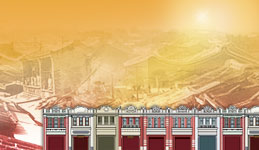          

|
|

|
After we read the data from many books
and websites, it is known that life in the Wufu street (that is, “no
sky” street) as a newly developed commercial street is quite busy. In
the street, inland and foreign merchants gathered and dominated the
trading behaviors at the harbor, including exporting and importing
products. We intended to conclusion the commercial behavior around the
"No sky"
street area. What we included was the commercial activities
during the good times of the "No sky" street area. The following
description in “The Appearance of Old Lukang”, written by Han Bao-De,
can help us understand the daily life in the "No sky" street area.
|
|
 Harbor
Harbor
During the
"No sky" street area's wonder years, the commercial activities at the
harbor could be divided into two categories. One is prow Hang. Its
activities were located mainly near the Dayou street in Cyuanchou.
Prow Hang usually owned large fleets which sailed between Taiwan and
the coastline area of mainland, mostly Cyuan and Sia. At the harbor,
dockworkers were busily unpacking cargos while the accountants of
prow Hang are doing stocktaking. Various commercial Hangs belonged
to another category. Lots of commodities piled up in the yards in
the commercial Hangs as well as inside the commercial Hangs.
Accountants were discussing with wholesalers about the conveyance of
commodities. There were not too many customers on the main street
but lots of coolies with heavy burden on their back, steps in
disarray, shouting and walking towards the Wufu Street, Checheng, or
Niousyutou, led by a leadman. |
|
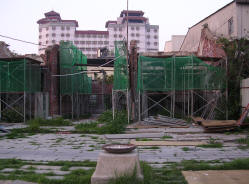 |
 |
|
The biggest prow company's relic- Le More |
Commercial companies center |
|
|
 TOP
TOP |
|
 In the Wufu Street
In the Wufu Street
The Wufu Street, the newly built street, was full
of jobbers from all places. They usually had a bearer beside them
but some carried a big baggage on their back. They surveyed the
commodities that their village needed along the street and when they
decided, they started to negotiate the price with the storekeeper or
the accountant. The outcries and the shouting of harbor bearers was
everywhere in the Sanlichang Street and the jobbers’ outcries echoed
around the whole street. In addition, the market between the Tienhou
Temple and the
Chenghuang Temple was started.
The front of the Chenghuang Temple was crowded with Fishermen, who
started working very early in the morning. They just returned with
their harvest. They were starving and ate in a rude way. Some
crewmen who were tired of the food on the boat also came to enjoy
some food. |
|
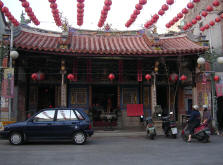 |
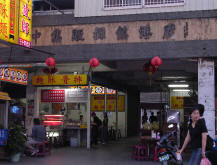 |
|
Chenghuang Temple |
The food court in front of Chenghuang temple |
|
|
 The Shallow Harbor
The Shallow Harbor
At the shallow
harbor, we could see from Lioulu harbor to the upper reaches of Yandau
creek. First we saw groups of smaller boats parked around the
Jioukanduan, then some scattered little boats. During that time, the
harbor had already
silted up, most commodities must be
transferred from the outport, conveyed to shallow harbor through river
and then to Lukang, so better small boats all went to the outport to
convey the commodities of big ships.
All the
pedestrians, wagons, and bearers went towards the Cingyun Road and then
Wufu Road. The bullock-carts in the street and part of the pedestrians
walked on the sand road along the river to Chewei. Most bullock-carts
stayed here to have their cart cleaned or tires fixed. Of course it's
possible to hear one or two old people mentioning about how much food
could be conveyed in the past when cars could go directly to Checheng
but now it is too crowded to get in. It is also necessary to go to that
iron shop to buy a quick and sharp reaping hook. After arriving at
Checheng, ding-dong sounds were heard here and there. There were various
kinds of ironware hung in the store. |
|
 TOP
TOP |
|
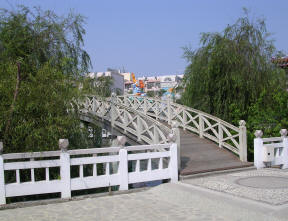 |
|
Today's shallow harbor |
|
|
To sum up,
as the commercial center of Lukang, Wufu Street effectively
gathered various kinds of people in this place and maintain
Lukang's reputation as the second largest city in Taiwan
after the harbor lost its function. |
|
《Next
Buildings…》 |
|
|

